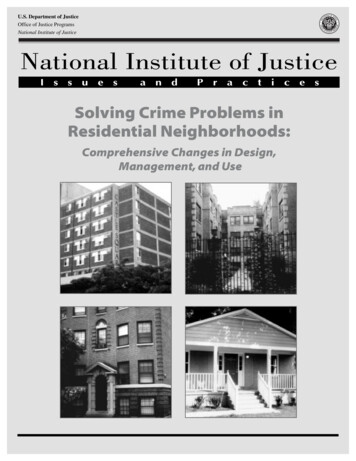
Transcription
U.S. Department of JusticeOffice of Justice ProgramsNational Institute of JusticeSolving Crime Problems inResidential Neighborhoods:Comprehensive Changes in Design,Management, and Use
U.S. Department of JusticeOffice of Justice Programs633 Indiana Avenue N.W.Washington, DC 20531Janet RenoAttorney GeneralU.S. Department of JusticeJohn C. DwyerActing Associate Attorney GeneralLaurie RobinsonAssistant Attorney GeneralJeremy TravisDirector, National Institute of JusticeJustice Information CenterWorld Wide Web Sitehttp://www.ncjrs.org
U.S. Department of JusticeOffice of Justice ProgramsNational Institute of JusticeSolving Crime Problemsin Residential Neighborhoods:Comprehensive Changes in Design,Management, and UsebyJudith D. Feins, Ph. D.Joel C. Epstein, Esq.Rebecca WidomApril 1997Issues and Practices in Criminal Justice is a publication series of the National Institute ofJustice. Each report presents the program options and management issues in a topic area,based on a review of research and evaluation findings, operational experience, and expertopinion on the subject. The intent is to provide information to make informed choices inplanning, implementing, and improving programs and practice in criminal justice.
National Institute of JusticeJeremy TravisDirectorJohn SpevacekSamuel C. McQuadeProgram MonitorsAdvisory PanelRonald Clarke, DeanRutgers UniversitySchool of Criminal Justice15 Washington StreetNewark, NJ 07102Dan Fleissner, ManagerResearch and GrantsSeattle Police Department,Community Policing Bureau700 Third Avenue, Room 540Seattle, WA 98104Severin Sorensen, PresidentSPARTA Consulting Corporation7313 Woodmont AvenueBethesda, MD 20814Stephen TiseTise, Hurwitz, and Diamond, Inc. Architects370 Washington StreetBrookline, MA 02146Prepared for the National Institute of Justice, U.S. Department of Justice by Abt Associates Inc.,under contract #OJP-94-C-007. Points of view or opinions stated in this document are those ofthe authors and do not necessarily represent the official position or policies of the U.S.Department of Justice.The National Institute of Justice is a component of the Office of Justice Programs, which also includes the Bureau ofJustice Assistance, the Bureau of Justice Statistics, the Office of Juvenile Justice and Delinquency Prevention, and theOffice for Victims of Crime.NCJ 164488
Table of ContentsForeword .PagePageviiAcknowledgements.ixExecutive Summary.xiChapter 1: Crime and Place: What Do We Know? .1Objectives and Audience .Overview of theReport .What Is Place-Specific Crime Prevention? .Displacement of Crime or Diffusion of Benefits? .Need for Continuing Research .Introduction to Selected Programs .Public Housing Development: Lockwood Gardens, Oakland, California .Private Rental Complex: Castle Square Apartments, Boston, Massachusetts .Urban Neighborhood: Genesis Park, Charlotte, North Carolina .Suburban Community: The Village of Oak Park, Illinois .Other Sites Contacted by Telephone .11334556677Chapter 2: Crime and Place: Defining the Problem .11Involving Key Players .Enlisting Police Involvement .Building on Existing Relationships .Organizing the Community .Obstacles to Coordination and Cooperation .Resident Involvement in Crime .Past Tensions .Fear of Retaliation .Population Changes .Negative Press .Defining the Crime Problem .Gathering Information About Crime and Disorder .Linking Crime to Location .Identifying Key Physical Features .Identifying Managers and Potential Managers of an Area .Why Is Management Important? .11111212131313131313141415151919
PageWho Are the Managers? .Analyzing Current Management .Analyzing Current Use Patterns of an Area .Who Lives Here? .Who Works Here?.Drug Dealers and Organizations .Gangs .Who Else Uses the Area? .2021212222232424Planning for Change: Program Design .27A Primer of CPTED Strategies and Tactics .Selecting Approaches that Work for Your Community .Maintaining a Menu of Approaches .Identifying Resources .Types of Resources .Priority or Key Resources .First Steps: Where to Begin .Enhanced Security .Resident Organization .Choosing Where to Begin .Getting Ahead of the Problem .2730313131323434353637Chapter 4: Making Changes: Program Implementation .39Changing the Physical Environment .Changing Management: Who’s in Charge Here? .Making Changes in Security Management .Policing .Private Security .Residents .Making Changes in Property Management .39474748495051Chapter 5: Putting the Pieces Together: Results and Lessons Learned .59Changing Uses of an Area: Results of Place-Specific Crime Prevention .Taking Back the Turf .Reducing Crime and Keeping It Down .Genesis Park.Lockwood Gardens .Oak Park .Castle Square Apartments .Five Oaks .5959616162626262Chapter 3:
PageWere the Changes Just Displacement? .Lessons Learned .Changing Attitudes .Managing Security .Maintaining Communication .Securing the Right Kinds of Funding .Taking Advantage of Technology .Avoiding the Pitfalls of the Past .Crime and Place Revisited .636464656565666667Appendix A: Glossary of Acronyms .69Appendix B: Review of the Research Literature .71Appendix C: Guidelines and Checklists for Place-Specific Crime Prevention Programs .83Appendix D: Sources of Information, Training, and Technical Assistance .91Appendix E: Summary of Program Characteristics for 11Place-Specific Crime Prevention Programs .97Appendix F: Crime Statistics for Selected Sites .109
ForewordCan residential neighborhoods be designed—or redesigned—to promote safety? This Issues and Practices report isintended to inform law enforcement officials, urban plannersand architects, multifamily housing managers, and publichousing administrators about place-specific crime prevention—the diverse array of coordinated environmental design, property management, and security strategies that canbe employed to reduce crime and fear of crime in urban andsuburban neighborhoods. Practical lessons gleaned from avaried set of sites that blend physical design changes andmanagement changes are presented. These approaches areconsistent with and support the community-oriented andproblem-oriented policing models being implemented bymany law enforcement agencies across the United States.Today’s place-specific crime prevention approaches supersede earlier theories about environmental design, drawing onmore active strategies and management techniques yet retaining a focus on specific locations. Municipalities, publichousing authorities, private developers, and community organizations in city and suburban neighborhoods can choosefrom a variety of strategies to strengthen their own particularcrime prevention efforts. This report emphasizes that localleaders of the groups or agencies initiating change—togetherwith residents, local law enforcement administrators, andgovernment and community leaders—are the people bestsuited to determine the most appropriate place-specific crimeprevention approaches. Also underscored is the importanceof improving management practices and using culturallysensitive policing strategies in combination with environmental design or redesign solutions.Housing developments—both public and private—are beingrenovated in many parts of the United States. As this reportshows, pairing physical design changes with managementchanges that support, facilitate, and reinforce their preventive effects on disorder and illegal activity can be a highlyeffective strategy for combating criminal activity. This report builds on prior National Institute of Justice researchefforts, including Partnerships for Neighborhood CrimePrevention and other research conducted during the past 20years. Many of these publications and related documentationare available from the National Institute of Justice.Place-specific crime prevention may involve opening up apublic space to create better natural surveillance, shuttingdown a crack house, modifying leases and tenant screeningpractices, training residents to patrol their own buildings, orcreating on-site police substations or security offices. Themost effective place-specific crime prevention strategiestake into account the geographic, cultural, economic, andsocial characteristics of the target community. Thus, theselection of place-specific crime prevention tactics andelements should be made in close collaboration with thecommunity, after sustained observation of its current patterns of use.By emphasizing that crime prevention is not a “one size fitsall” effort, and that some neighborhoods or communities willrequire more attention and ingenuity than others in craftingeffective strategies, this report stresses the importance of athorough analysis of local problems and needs, as well asongoing monitoring and evaluation of the place-specificstrategies selected and their effectiveness in reducing crimeand disorder.Jeremy TravisDirectorNational Institute of JusticeForewordvii
AcknowledgementsWe wish to thank the many individuals in the study sites whopatiently answered our questions and provided us withmaterials about their efforts to prevent crime and increasesecurity in residential settings. In particular, we thank thehosts and lead respondents at each site we visited: Mr. Arthur Winn (Winn Development Company) andMs. Deborah Backus (Castle Square Tenants Organization, Inc.), Boston, Massachusetts; Ms. Patricia Garrett (Charlotte-Mecklenburg HousingPartnership) and Mr. John Hayes (Charlotte HousingAuthority), Charlotte, North Carolina; Lieutenant David Krauss (Oakland Housing Authorityand Oakland Police Department), Oakland, California;and Mr. Frank Pond (Rehabilitation Supervisor, Village ofOak Park), Oak Park, Illinois.We hope that these respondents will convey our thanks to themany others from their sites with whom we met or spokeduring the course of this research. In addition, we thank theindividuals from the 11 other sites whom we contacted bytelephone for extensive information-gathering about theirplace-specific crime prevention efforts.The four advisory board members for this project providedvery useful guidance during a one-day meeting in Washington, DC, as well as through periodic phone consultations andreviews of the draft report. We extend our thanks to Dr.Ronald Clarke of the Rutgers University School of CriminalJustice; Mr. Dan Fleissner, Manager of Research and Grantsfor the Seattle Police Department; Mr. Severin Sorensen,President of SPARTA Consulting Corporation; and Mr.Stephen Tise, principal of Tise, Hurwitz, and Diamond, Inc.(architects).A number of other individuals participated in the advisorymeeting in June 1995 and provided valuable suggestions forshaping this work. We thank Dr. Adele Harrell (UrbanInstitute), Dr. Harold Holtzman (U.S. Department of Housing and Urban Development, Office of Policy Developmentand Research), and Mr. Robert Langworthy (National Institute of Justice [NIJ]) for their interest and contributions.John Spevacek, program manager for the development ofthis report at NIJ, provided support and beneficial advice tothe project. We thank Richard Titus, NIJ’s crime preventionspecialist, for inspiring us to take a new look at crimeprevention through environmental design (CPTED) in the1990’s and for guiding and assisting us throughout theproject. Cheryl Crawford, the contracting officer’s technicalrepresentative at NIJ, and Virginia Baldau, director of NIJ’sProgram Development Division, Office of Development andDissemination, provided helpful suggestions for improvingthe report.At Abt Associates, Theodore Hammett’s technical reviewbrought about important improvements to our drafts. JonNorman ably assisted us in completing the project. MaryEllen Perry and Myraida Rivera masterfully coordinatedproduction of the report, and Karen Minich and WendySanderson expertly prepared the final publication. We thankthem all.Judith D. FeinsJoel C. EpsteinRebecca WidomAbt Associates Inc.Acknowledgementsix
Executive SummaryThis publication examines place-specific crime prevention:making changes for security and crime prevention in urbanand suburban neighborhoods. Place-specific crime prevention refers to programs of physical design changes, publicand private management changes, and use-pattern changesthat are targeted to a particular place and its crime problems.The goal of this report is to inform law enforcement officials,urban planners and architects, multifamily housing managers, and public housing administrators about the diversearray of coordinated environmental design and managementstrategies that can be employed to reduce crime and fear ofcrime in housing complexes and residential neighborhoods.This approach works well with the community-oriented andproblem-oriented policing models being implemented bylaw enforcement agencies across the United States.Place-specific crime prevention approaches go beyond narrow theories about environmental design or defensible space.The integration of strategies to modify the use and management of places has strengthened environmental design orredesign as a practical approach to crime prevention invaried settings. Place-specific crime prevention builds oncrime prevention through environmental design (CPTED,physical changes) and draws on the results of research onactive crime prevention tactics (such as community policingand community crime prevention) to emphasize modification of design, use, and management of a specific place toprevent and reduce crime.This report presents practical lessons gleaned from a variedset of sites operating security and anticrime programs thatcombine physical design changes and management changes.Efforts by municipalities, public housing authorities, privatedevelopers, and nonprofit organizations in city and suburbanneighborhoods are the focus. The information presentedshould prove useful to practitioners and agencies creatingtheir own place-specific crime prevention programs. Thefindings in this report stress that the nature and configurationof the place-specific crime prevention approach are bestdetermined by local leaders of the groups or agencies initiating change, with the cooperation and participation of othergovernment and community leaders, local law enforcementadministrators, and residents. The importance and efficacyof improved management practices and culturally sensitivepolicing strategies, in combination with environmental design or redesign solutions, are also stressed.This publication is based on a combination of informationfrom programs around the country, a review of the literature,and consultation with experts in the field. Visits were madeto four sites, each representing a different place-specificcrime prevention approach: Castle Square Apartments, a private rental housingcomplex in Boston, Massachusetts; Lockwood Gardens, a development of the OaklandHousing Authority in East Oakland, California; The central city Genesis Park neighborhood in Charlotte, North Carolina, and The suburban village of Oak Park, Illinois.Telephone interviews with 11 other sites provided additionalexamples of place-specific interventions. In addition to adiversity of CPTED approaches, the selected sites display arange of innovative policing and housing management strategies; most have achieved measurable success in reducingcrime.Examples of place-specific crime prevention approachesfrom the study sites include: closing pedestrian tunnels andopening up hidden areas to resident and management view(Castle Square Apartments, Boston); shutting down a crackhouse through civil lawsuits (Clinton Hill neighborhood,Brooklyn, New York); fencing and gating the community(Lockwood Gardens, Oakland; Mar Vista Gardens, LosAngeles, California; Diggs Town, Norfolk, Virginia); rerouting traffic and limiting vehicular access to a community(Genesis Park, Charlotte, North Carolina; Oak Park, Illinois;Bridgeport, Connecticut; Five Oaks, Dayton, Ohio); installing high-technology pan-tilt-zoom cameras as the centerpiece of a three-development surveillance system (GrantManor, Boston); creating on-site police substations or security offices (Lockwood Gardens, Oakland; Oak Park, Illinois); and organizing the community to approve a special taxassessment for better street lighting and other public improvements (El Cortez Heights, Tucson, Arizona).The most effective place-specific crime prevention strategies are those that take into account the geographic, cultural,economic, and social characteristics of the target community. Thus, the selection of place-specific crime preventionExecutive Summaryxi
strategies and tactics should be made in close collaborationwith the community, after sustained observation of its current patterns of use. The experiences of the study sites revealtwo major lessons: xiiPhysical design modifications, management changes,and changes in use should be tailored to specific locations and coordinated in their planning and implementation.The most effective security and crime prevention effortsare those that involve a coalition of different playersworking together to define the problem and then seeksolutions.Solving Crime Problems in Residential NeighborhoodsBy emphasizing that crime prevention is not a “one size fitsall” effort, and that some communities may require moreattention and ingenuity than others in crafting effectivestrategies, this report stresses the importance of a thoroughanalysis of the problems and needs of a given community, aswell as ongoing monitoring and evaluation of the placespecific strategies selected.The varied examples presented in this publication demonstrate that physical design changes and managementchanges—enhanced security, improved property management, and greater resident involvement—can be combinedeffectively to combat criminal activity, reduce disorder,improve safety, and enhance the quality of life in a variety ofurban and suburban residential settings.
Chapter 1Crime and Place: What Do We Know?This chapter presents an overview of place-specific crimeprevention: coordinated programs of physical redesign andpublic and private management changes targeted to a particular community and its crime problem. The first sectionsets out the objectives and organization of the report andprovides a brief discussion of the sites studied. The nextsection gives an overview of the report’s organization. Thethird section discusses the sources of place-specific crimeprevention and the issue of crime displacement and diffusionof crime control benefits. The final section introduces thearray of sites from which data and examples will be drawnthroughout the report.Objectives and AudienceThe goal of this publication is to inform law enforcementofficials, urban planners and architects, multifamily housingmanagers, and public housing administrators of the diversearray of coordinated environmental design and managementstrategies that can be employed to reduce crime and fear ofcrime in urban and suburban neighborhoods. The placespecific crime prevention approach is consistent with andsupports the community-oriented and problem-oriented policing models being implemented by many law enforcementagencies across the United States. This publication emphasizes the importance and efficacy of improved managementpractices and culturally sensitive policing strategies in combination with environmental design or redesign solutions.In preparing this report, the authors have built on priorresearch efforts, including Partnerships for NeighborhoodCrime Prevention1 and other research sponsored by theNational Institute of Justice during the past 20 years.2 Thereport also incorporates practical lessons gleaned from theefforts of municipalities, public housing authorities, privatedevelopers, and nonprofit organizations in city and suburbanneighborhoods to operate security and anticrime programsthat combine physical design changes and managementchanges.The nature and configuration of these place-specific crimeprevention approaches were determined by local leaders ofthe groups or agencies initiating change, with the coopera-tion and participation of residents, local law enforcementadministrators, and government and community leaders.Overview of the ReportChapter 1 describes place-specific crime prevention andbriefly describes the sites and programs from which information for this publication is drawn. Chapter 2 identifiestechniques for defining and analyzing the crime problem ina particular locale. It considers the physical features of anarea that influence crime and public safety, discusses theconcept of place management and ways of determining thestakeholders, and helps the reader think about how an area’suse—by residents and others—influences security. Chapter3 describes how the study sites have designed their interventions and draws lessons from their experiences. Programdesign includes not only selecting strategies and tactics butalso mobilizing available resources and knowing where andhow to start initiating change.Chapter 4 describes program implementation. The firstsection examines how to bring about changes in the physicalenvironment through design and/or redesign and renovation.The second section discusses options for changing management—including policing, property management, and therole of residents—in order to solidify and sustain the securityfeatures of the redesign.In conclusion, chapter 5 presents an examination of results—what sites claim to have achieved through their security andcrime prevention efforts. The results discussed in the firstsection include “taking back the turf” (reclaiming the area forlegitimate use by residents and others), reducing crime andkeeping it down, and dealing with any issues of crimedisplacement. The second section summarizes a number oflessons shared by the diverse set of communities profiled inthis report. The chapter ends with a recapitulation of themajor points of the publication.Several appendixes provide additional material, ideas, andcontact information for the resources needed to implementplace-specific crime prevention programs:Crime and Place: What Do We Know?1
Sources of InformationThis report is based principally on telephone interviews with 11 programs across the United States and site visitsto four locales, each representing a different place-specific crime prevention approach. The sites visited were:1.Castle Square Apartments, a private rental housing complex in Boston, Massachusetts.2.Lockwood Gardens, a development of the Oakland Housing Authority in East Oakland,California.3.The central city Genesis Park neighborhood in Charlotte, North Carolina.4.The suburban village of Oak Park, Illinois.In addition to representing diverse crime prevention through environmental design (CPTED) approaches, theselected sites displayed a range of innovative policing and housing management strategies; most haveachieved measurable success in reducing crime in the target areas.The visited sites were selected from an initial pool of over two dozen that were identified in the literature or byexperts in the field as representing the best recent examples of place-specific crime prevention
Executive Summary xi Executive Summary This publication examines place-specific crime prevention: making changes for security and crime prevention in urban and suburban neighborhoods. Place-specific crime preven-tion refers to programs of physical design changes, publi










